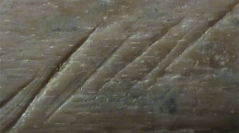

 Comptes Rendus Palevol
9 (4) - Pages 171-184
Comptes Rendus Palevol
9 (4) - Pages 171-184Bolomor Cave, located in Tavernes de la Valldigna (Valencia, Spain), contains a sedimentary deposit composed of seventeen stratigraphic levels ranging from MIS 9 to MIS 5e. This extensive sequence allows us to ask different questions about how the human groups of this chronological period related to their environment. We report several different strategies by which animal resources were obtained from level XII faunal assemblage (MIS 6). These practices range from scavenging to the complex hunting techniques, such as multiple predation. This practice is inferred in the case of horses (Equus ferus) on the basis of: (1) the proportional representation of skeletal elements (elements with high marrow content, such as stylopodials and zeugopodials); (2) age at death of these animals (from infantile to advanced adult); (3) the position and function of cutmarks and toothmarks (mainly oblique and longitudinal incisions on limb bones diaphyses); (4) archaeostratigraphic distribution of their remains in the assemblage; and (5) presence of refits among the bones located at this archaeostratigraphical line. Evidence of anthropogenic processing of small prey (Oryctolagus cuniculus and Cygnus olor) is also identified at level XII. These discoveries imply the development of techniques different from those used to capture large and medium ungulates. From this perspective, a variety of strategies to obtain animal food can be documented at Bolomor Cave. This phenomenon can be related to the highly adaptive subsistence strategies of these hominids, who could take advantage of the benefits offered by a diverse and rich environment. In general, the aim of this study is to provide data about the subsistence strategies of human groups from Bolomor Cave and contribute to knowledge about the human groups’ way of life of in the late Middle Pleistocene.
Middle Pleistocene, Bolomor Cave, Subsistence strategies, Hunting, Multiple predation, Scavenging, Small prey, Spain